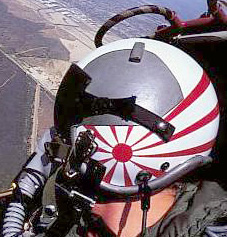 |
US Military Aviation
Flight Helmets
US NAVY 90s-today |
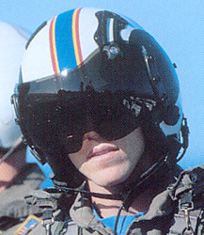 |
In the beginning of the 90s a new lightweight helmet was introduced in the US NAVY service. This helmet designated the HGU-55/P was characterized by a simple bungee visor, lightweight oxygen mask bayonet receivers and more confortable internal liner. This type of helmet was replaced in the second half of the 90s by a new helmet type: the HGU-68/P and the relevant variations expressively developed to US NAVY specifications. In this period helmets which incorporated the Cats Eyes Night Vision Goggles bracket were also introduced as well as the new model incorporating the "Combat Edge" system designed to improve high performance fighter pilot tolerance to high G maneuvers.
At the beginning of 2000 the new Joint Helmet-Mounted Cueing System (JHMCS) was introduced in service to be operatively flight tested on F/A-18E,F Super Hornet. During the 90s the MBU-14/P (and other US NAVY versions of USAF MBU-12/P) were normaly utilized as well as the new low profile MBU-23/P and MBU-24/P NAVY version of USAF MBU-20/P.
HGU-55/P ; HGU-55/E
The HGU-55/P helmet assembly is made of fiberglass fabric molded with epoxy resin. It is equipped with energy-absorbing styrofoam liner but a custom fitted Thermoplastic liner (TPL) was also available. The helmet is equipped with a single snap-on visor that eliminates the visor housing for reduced weight and a lower profile.The HGU-55/P integrate the H-154A/AIC Headset and lightweight oxygen mask receiver kit.
This helmet was normally utilized with MBU-14/P and the other US NAVY variant of USAF MBU-12/P oxygen mask.
The HGU-55/E is identical to the standard HGU-55 except that a protective visor assembly replaces the bungee visor. Its protective visor housing allows easy movement of the impact-resistant polycarbonate lens and locks the lens securely up or down.
|
|
US NAVY F-14A Naval Flight Officer wearing an HGU-55/P and MBU-14/P oxygen mask.
(US NAVY) |
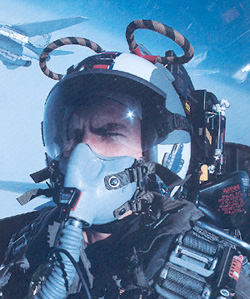
|
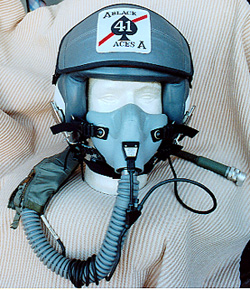
|
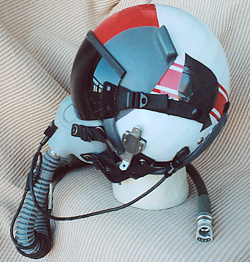
|
HGU-55/P of USN squadron VF-41 "Black Aces" and oxygen mask MBU-14/P. This helmet's design was used by VF-41 "Black Aces" during the early 90s. |
US NAVY Fighter Weapons School "TOP GUN" instructor with an HGU-55/P and oxygen mask MBU-12/P. This instructor is on board of an US NAVY TF-16N Fighting Falcon.
(Osprey Publishing Ltd.) |
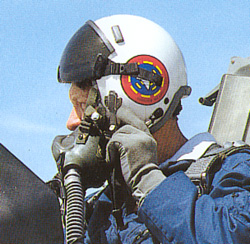
|
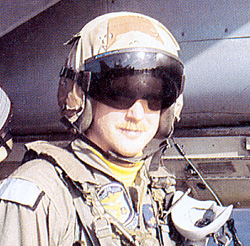
|
F-14 pilot during operation "Desert Storm" wearing an HGU-55/P covered with desert camuflage cover.
(Motorbooks International Publisher) |
| F-14 NFO with HGU-55/P and an MBU-14/P oxygen mask with USAF style mic. and external USN amplifier (the same used on some USN MBU-5/P). Note the aluminum cast oxygen mask receivers installed instead of the lightweight ones. (US NAVY) |
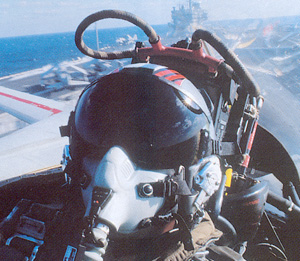
|
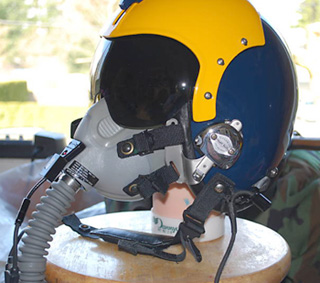
|
Even if at first sight this helmet seems to be an HGU-33/P, it is instead an HGU-55/E manufactured by Flightsuits (Gibson and Barnes). The HGU-55/E is identical to the standard HGU-55 except that a protective visor assembly replaces the bungee visor. Its protective visor housing allows easy movement of the impact-resistant polycarbonate lens and locks the lens securely up or down. (Maurizio Bressan) |
| US Navy Blue Angels demonstration team pilot with HGU-55/E fitted with a boom mic. The MBU-14/P mask is in the cockpit, but is not used during demonstrations. The only time the Blue Angels use O2 masks is during high altitude transits. (www.steehouwer.com) |
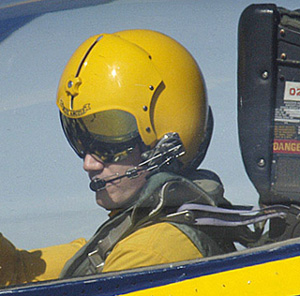
|
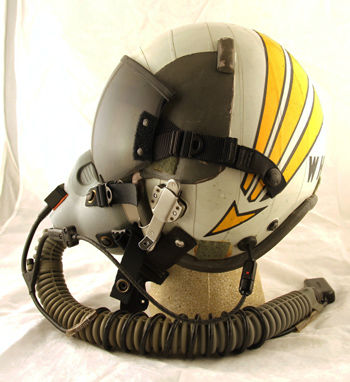
|
US Navy HGU-55/P of VFA 151 and oxygen Mask MBU-14/P (Chameloon) |
| HGU-55/P of VFA 113 and Oxygen Mask MBU-14/P (Chameloon) |
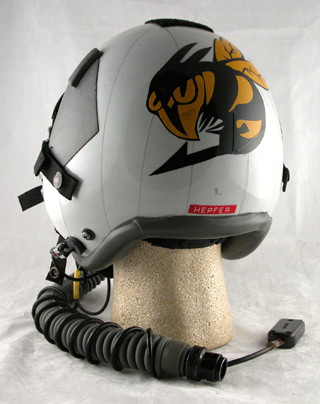
|
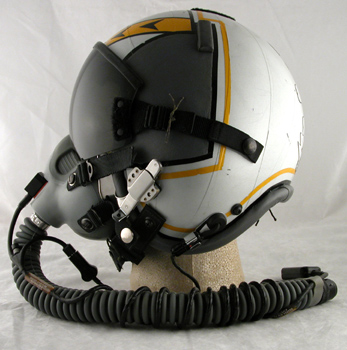
|
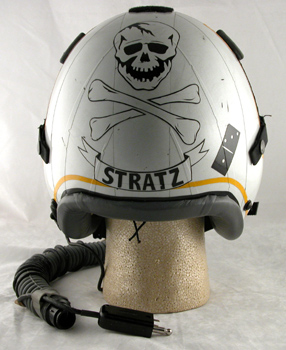
|
HGU-55/P of USN squadron VF-84 "Jolly Rogers" and oxygen mask MBU-14/P. This helmet's design was used by VF-84 during the early 90s (Chameloon). |
| Unusual HGU-55/P customized with black leather edgeroll and lateral pieces and with a special internal energy-absorbing styrofoam liner . |
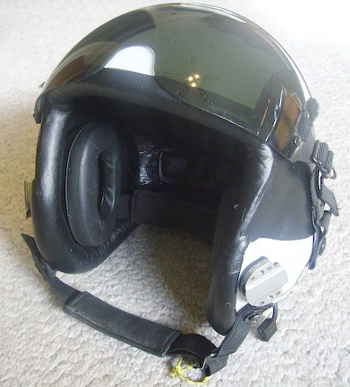
|
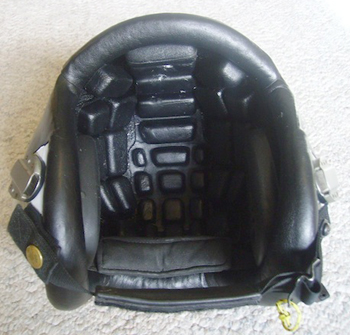
|
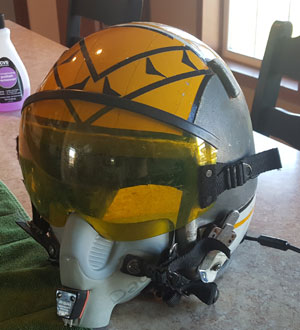
|
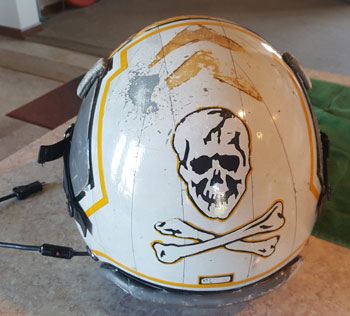
|
Another HGU-55/P of USN squadron VF-84 "Jolly Rogers" and oxygen mask MBU-14/P. This helmet's design was also used by VF-84 during the early 90s. |
| HGU-55/P of USN squadron VF-111 "Sundowners" . This helmet's design was used by VF-111 during the early of the 90s. |
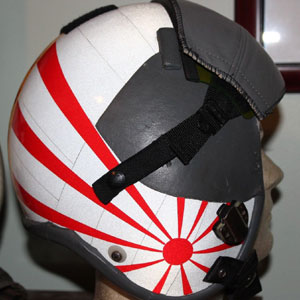
|
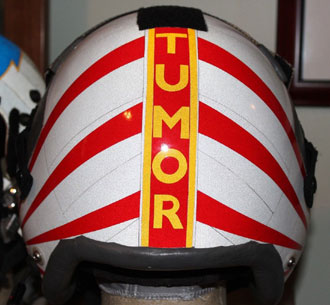
|
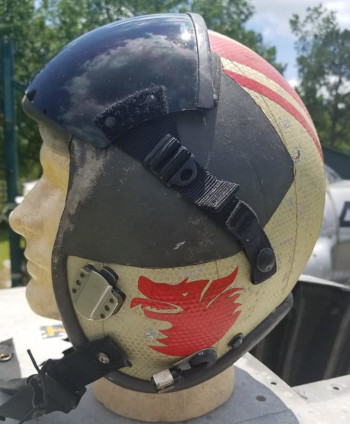
|
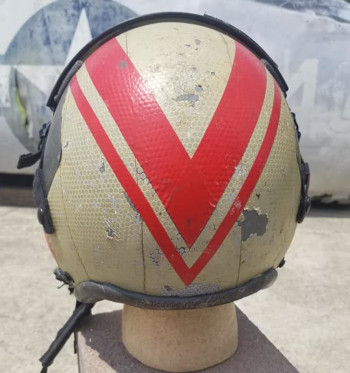
|
Interesting HGU-55/P of USN squadron VF-1 "Wolfpack" used during the early of the 90s. (John Slezak) |
ALPHA TYPE HELMET
The Advanced Lightweight Protective Helmet Aviation (ALPHA) helmets are produced by United Kingdom company Helmet Ltd. Some of these helmets have been modified for use in the USMC version of AV-8B Harrier Night Attack aircraft. The modifications include cast type bayonet receivers, communications, and early T NVG mount bracket as used on HGU-66/P. Not many ALPHA helmets have been modified and used by USMC pilots on US version of AV-8B. |
|
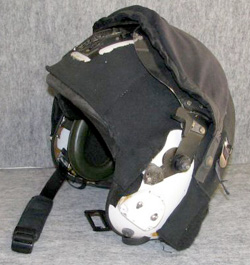
|
USMC version of United Kingdom ALPHA helmet modified for utilization on US variant of AV-8B (Surplusagent) |
| USMC ALPHA helmet with a velcro attached cover made from black velvet like material and a clear visor lens with cover.(Surplusagent) |
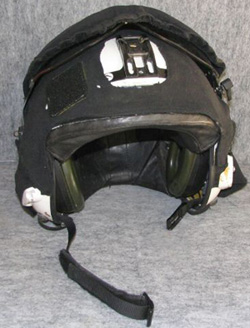
|
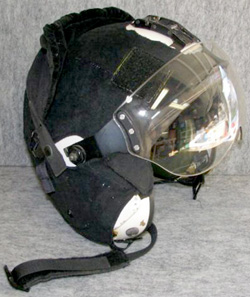
|
The USMC ALPHA helmet has been modified with new communications, cast bayonet receivers and early T mount night visor bracket.(Surplusagent) |
 |
HGU-56/P
The dual visor HGU-56/P helicopter helmet is equipped with boom mounted M-87A/A1C microphone, and visor housing platform to accept night vision goggles. Visor housings are available for equipment application in Apache, Cobra, Blackhawk helicopter and V-22 Osprey Tiltrotor. The HGU-56/P can also be adapted to allow use of the standard USAF and USN oxygen mask for high altitude operation. The helmet shell is fabricated from an advanced graphite composite for lighter weight and impact protection. |
|
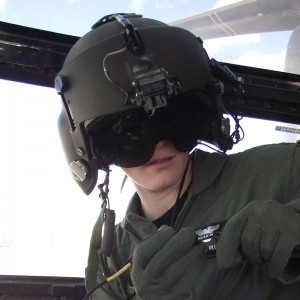
|
USMC female pilot under training with HUG-56/P used on MV-22 Osprey |
| USMC Osprey pilot with HGU-56/P flight helmet modified with oxygen mask receivers |
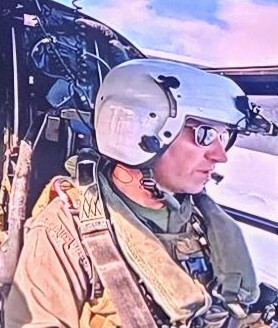
|
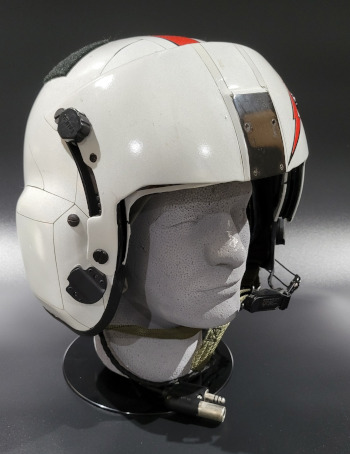
|
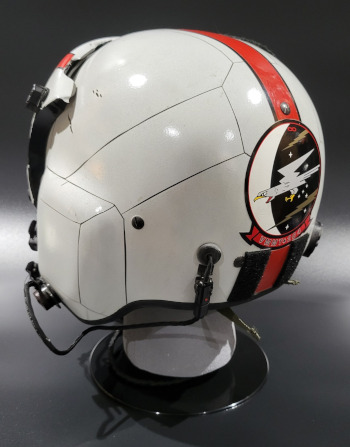
|
USMC HGU-56/P from an former instructor with Marine Medium Tiltrotor Training Squadron 204 (VMMT-204) which is the MV-22 Osprey training squadron for the United States Marine Corps and US Navy along with the Fleet Replacement Squadron for pilots and aircrew. |
 |
HGH-66/P
The HGU-66/P helmet is designed as a mount platform for the Cats Eyes Night Vision Googles. The helmet shell is a rigid material made of pressure-molded, laminated Kevlar cloth. The helmet has the Integrated Chin/Nape Starp Assembly which is a unique one-piece assembly that threads through the helmet and adjusts at the chinstrap and nape area.
A nominal one-half inch styrofoam energy absorbing liner is the primary impact attenuation and a preformed Thermoplastic Liner (TPL) provides an easily fitted, lightweight, confortable custom liner. An NVG mount plate can be placed on the top frontal area of the helmet shell and safety visor it is also provived to replace the neutral grey visor when the Cats Eyes NVGs are utilized. This helmet is utilized with US NAVY MBU's series oxygen mask, which are secureb by two standard aluminum cast bayonet receivers. |
|
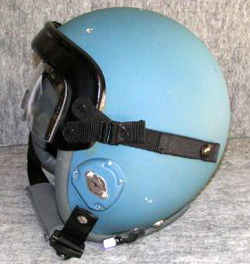
|
Test flight helmet custom built by Flight Suit Ltd. used on AV-8B. This helmet incorporates some of the features later used on standard HGU-66/P like the safety visor and the early T mount night vision bracket (Surplusagent) |
| Flight Suit Ltd. Test flight helmet used by Mc Donnel Douglas AV-8B test pilot. This helmet was used for test evaluation for night vision system. It is clear that from this type of helmet the HGU-66/P concept was born.(Surplusagent) |
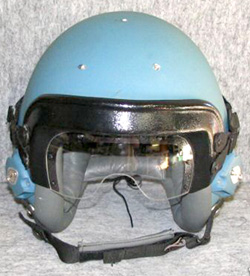
|
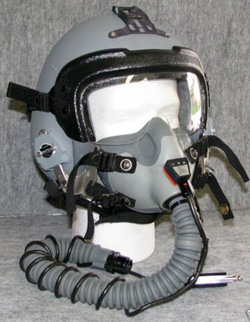
|
Another test flight helmet developed for test evaluation for night vision system on AV-8B. Although similar to the HGU-66/P , this helmet has some very minor differences, but it is obvious that from this helmet the concept for the 66/p was born. This prototype is equiped with safety visor, early T mount night visor bracket and MBU-14/P oxygen mask (Surplusagent) |
| HGU-66/P with camuflage protective cloth and dark visor. A black protective cloth covers the T night vision bracket to avoid cratches or damage on helmet's visor. (Flighthelmet.com) |
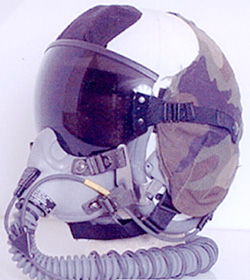
|
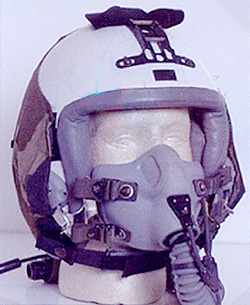
|
HGU-66/P with NVG mount plate visible under the protective cloth. (Flighthelmet.com) |
| U.S.M.C. HGU-66/P with safety clear visor and green MBU-14/P oxygen mask secured on lightweight receivers. In this helmet the NVG mount plate has been removed. |
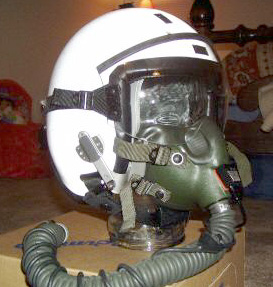
|
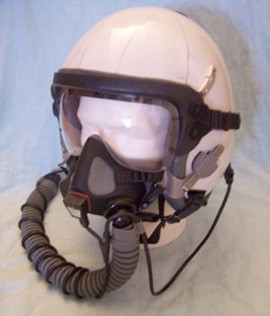
|
HGU-66/P modified with NVG plate mounting brackets and MBU-23/P low profile oxygen mask. |
| U.S.M.C. HGU-66/P with the marking of VMFA 312 with safety visor and MBU-14/P oxygen mask. |
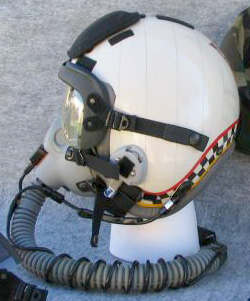
|
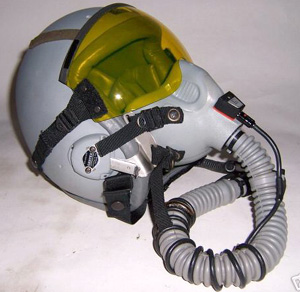
|
HGU-66/P with yellow visor and MBU-14/P oxygen mask. |
| HGU-66/P with MBU-23/P oxygen mask. (CSARdude) |
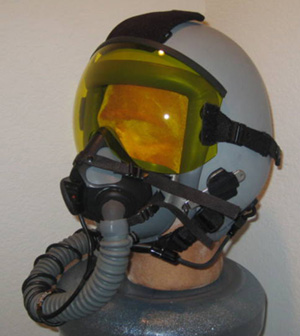
|
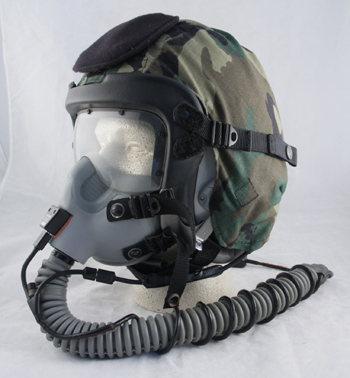
|
USMC HGU-66/P of VMFA 312 and MBU-14/P oxygen mask (Chameloon). |
| Possible HGU-66/P with external boom mounted microphone and avionics used on OV-10 Bronco |
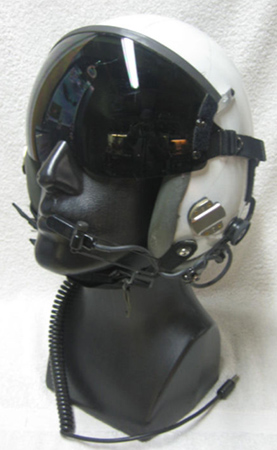
|
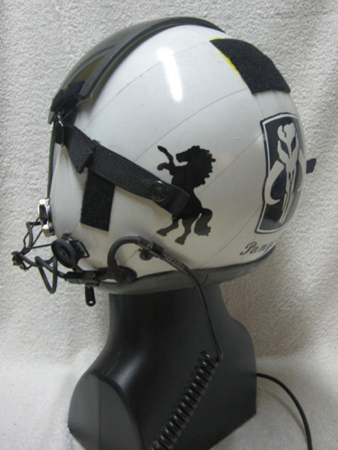
|
 |
TAC AIR HELMET (Modified HGU-55/P)
This helmet is the first prototype, based on modified HGU-55/P, proposed by Gentex Corp for a 600 knot windblast visored helmet for use by the USAF and US Navy. The design was accepted by the Navy and the current production HGU-68 can trace its roots all the way back to this one particular helmet. The helmet has the Integrated Chin/Nape Starp Assembly which is a unique one-piece assembly that threads through the helmet and adjusts at the chinstrap and nape area. Interesting features on this early prototype design are the 600 knot visor assembly which includes a dark lens suited for the MBU-14 shape mask , and the lens has black rail guides on it instead of the later clear edges. Also the visor knob guide has no removal tab , it is all one piece. The visor tracks are also unique with difference features by comparing to later HGU-68/p's. Another interesting feature is that the leather on the sides is shorter than the later 68's , and the visor cover snaps are located higher on the shell so the securing straps for the leather cover are much shorter.
|
|
| Gentex Tac-Air serial number One. This helmet is the first prototype proposed by Gentex Corp for a 600 knot windblast visored helmet for use by the USAF and US Navy. (Surplusagent) |
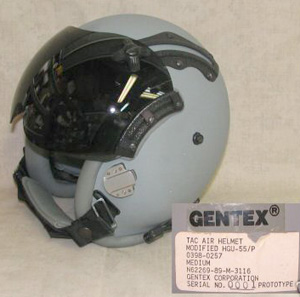
|
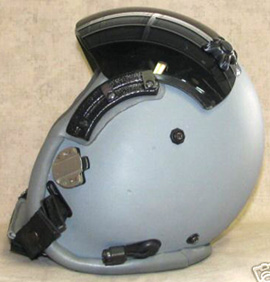
|
The 600 knot visor assembly includes a dark lens suited for the MBU-14 shape mask, and the lens has black rail guides on it instead of the later clear edges. Also the visor knob guide has no removal tab , it is all one piece. The visor tracks are also unique with difference features by comparing to later HGU-68/p's (Surplusagent) |
| Another interesting feature of this prototype is that the leather on the sides is shorter than the later 68's , and the visor cover snaps are located higher on the shell so the securing straps for the leather cover are much shorter. (Surplusagent) |
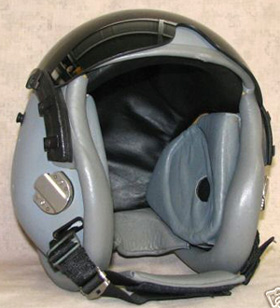
|
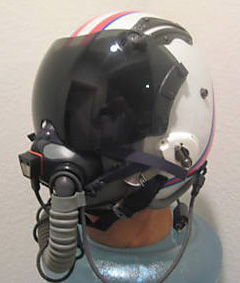
|
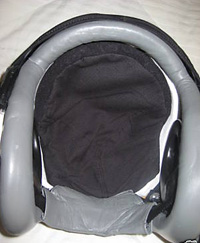
|
Squadron marked TAC AIR HELMET (Modified HGU-55/P) dated 1989 with cast bayonet receivers and MBU 23/P oxygen mask. (CSARdude) |
| Evaluation Squadron marked TAC AIR HELMET of early 90s with HGU 68/P style black lether edgeroll and lateral pads. This specimen was modified for the HGU-66/P style NVG mount plate accomodation and snap on visor. The helmet is shown with and MBU 23/P oxygen mask but in the early 90s it was used with the MBU-14/P. (CSARdude) |
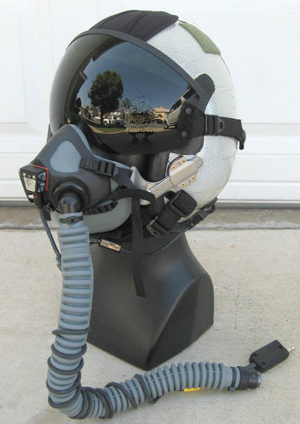
|
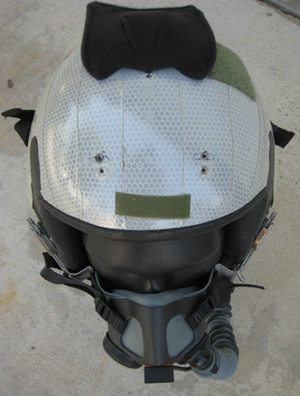
|
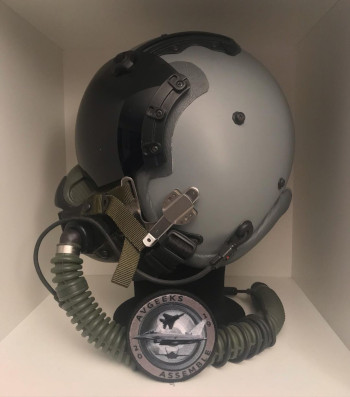
|
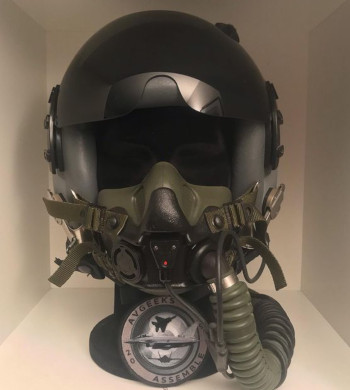
|
TAC AIR HELMET (Modified HGU-55/P) with unusual green variant of MBU 20/P oxygen mask (Philippe Tondeur collection) |
| TAC AIR HELMET (Modified HGU-55/P) in the color of the Test Squadron VX-23 (Philippe Tondeur collection) |
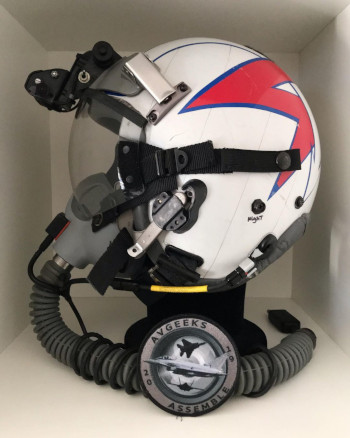
|
 |
HGU-68/P ; HGU-69/P
The HGU-68/P Tactical Aircrew (TACAIR) helmet is designed by Gentex to meet the requirements of the US NAVY and US MARINES CORPS in today's high G environment. The PRU-55/P shell is a rigid composite made of pressure molded, laminated graphite and balistic nylon (Graphlon).The helmet has the Integrated Chin/Nape Starp Assembly which is a unique one-piece assembly that threads through the helmet and adjusts at the chinstrap and nape area. A nominal one-half inch styrofoam energy absorbing liner is the primary impact attenuation and a preformed Thermoplastic Liner (TPL) provides an easily fitted, lightweight, confortable custom liner The HGU-68/P is equipped with a single visor system EEU-7/P with locking mechanism located left of center and lightweight bayonet receivers.The HGU-69/P helmet is alternative to the HGU-68/P and it is based on PRU-51/P shell with PRU-36/P or EEK-3/P visor. These helmets are utilized with US NAVY MBU's series oxygen mask.
|
|
| US NAVY HGU-68/P. Note the left of center visor's locking mechanism and the relevant track guides located on helmet's lateral sides. (Flighthelmet.com) |
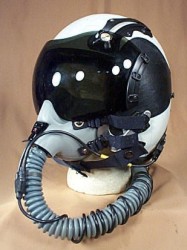
|
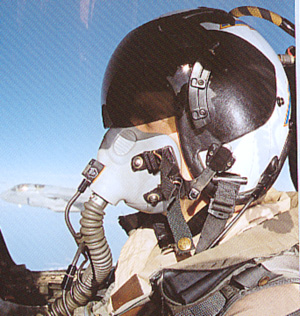
|
US NAVY Crewman on EA-6B Prowler wearing an HGU-68/P and MBU-14/P oxygen mask.
(TomCat Publishing Ltd.) |
US NAVY pilot with a modified HGU-68/P. The helmet has been customized with an HGU-66/P or HGU-58/P NVG mount bracket and a lightweight bungee visor replace the standard EEU-7/P visor assembly.
(US NAVY) |
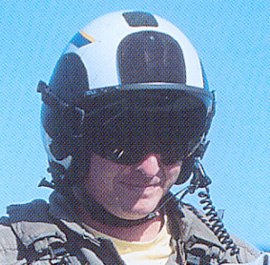
|
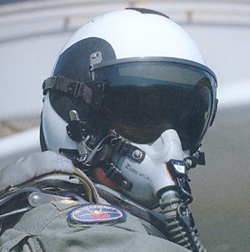
|
US NAVY F-18 pilot wearing a modified HGU-68/P. Also in this case the standard visor has been replaced with a lighweight one and the mounting brackets for NVG Detachable Helmet Mounting Plate Assembly have been installed. (US NAVY)
|
US NAVY HGU-68/P with bungee lighweight visor, mounting brackets for NVG Detachable Helmet Mounting Plate Assembly and the low profile oxygen mask MBU-23/P.
(Chameloon Flightgear on the web) |
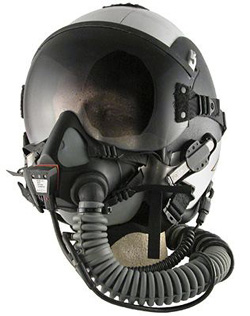
|
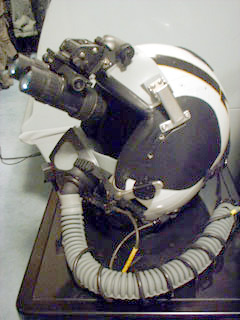
|
US NAVY HGU-68/P with NVG Detachable Helmet Mounting Plate Assembly and relevant AN/AVS-9 Aviator's Night Vision imaging System (ANVIS) "Catseye" installed. The oxygen mask is an MBU-23/P. |
| USMC flight instructor on T-45A wearing an HGU-68/P covered with the new desert digital pattern camuflage cover and low profile oxygen mask MBU-23/P. (USMC) |
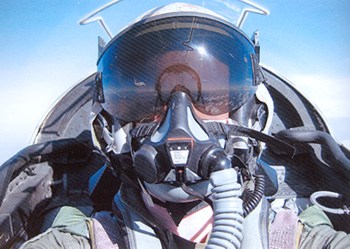
|
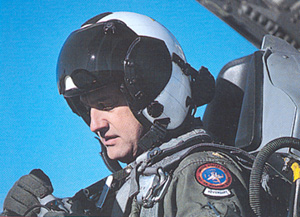
|
US NAVY pilot of VFC-13 Aggressor squadron on F-5E with HGU-68/P flight helmet. On F-5 and T-38 aircrafts the USN pilots utilize the USAF style MBU-12/P oxygen mask.
(US NAVY) |
USN F-18 pilot with HGU-68/P retrofitted with an HGU-84/P helicopter helmet visor.
(US NAVY) |
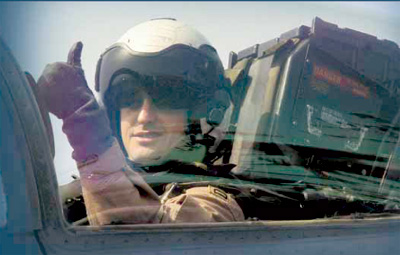
|

|
US NAVY HGU-68/P from VAQ 135 "Black Ravens" with mounting brackets for NVG Detachable Helmet Mounting Plate Assembly, anti-snap bayonet receivers, bungee lighweight visor and MBU-14/P oxygen mask. (Surpluagent) |
| USN HGU-68/P and MBU-23/P oxygen mask of VFA-2 (Chameloon) |
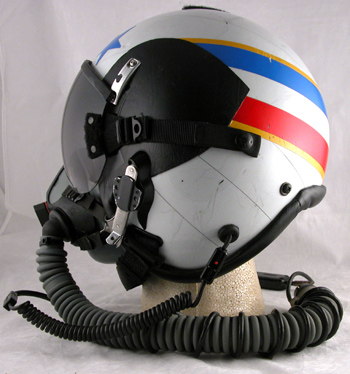
|
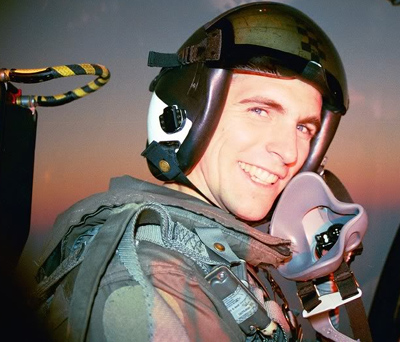
|
US Navy Prowler pilot from VAQ 137 with HGU-68/P and MBU-14/P oxygen mask. (US Navy) |
| USN HGU-68/P and MBU-23/P oxygen mask of VFA-103 Jolly Rogers. |
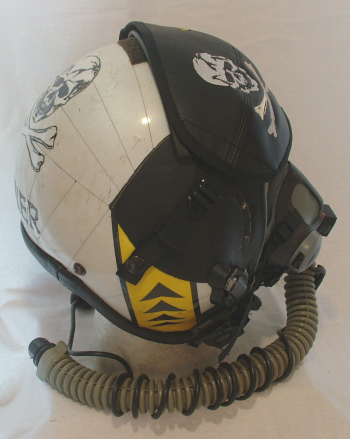
|
 |
HGU-70/P ; HGU71/P
The US NAVY HGU-70/P was the same as the HGU-68/P but with modification in avionic for the utilization on S-3 Viking. EEU-7/P visor and boom mounted microphone are installed.
The HGU-71/P helmet is alternative to the HGU-70/P and it is based on PRU-51/P shell with PRU-36/P or EEK-3/P visor. Oxygen mask MBU-15/P is also used by S-3 crew.
|
|
S-3B Viking pilot wearing an HGU-70/P.
(TomCat Publishing Ltd) |
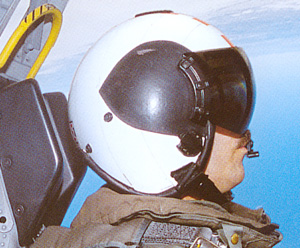
|
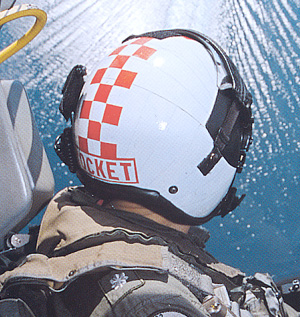
|
US Navy Pilot of VS-22 "Vidars" with an HGU-70/P. The EEU-7/P visor it is coverd with the leather cover attached to the lateral snap fastners.
(TomCat Publishing Ltd) |
| HGU-70/P decorated with the same design of the one worn by President George W. Bush during his flight on the S-3B Viking. Note the boom mounted microphone and the relevant cable and amplifier. (customflighthelmet.com) |
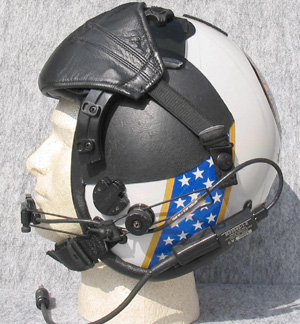
|
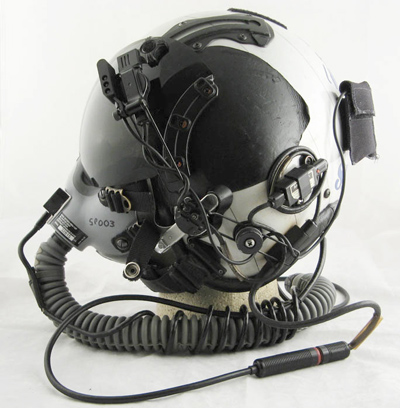
|
HGU-70/P of VS 32 and Oxygen mask MBU-15/P (Chameloon). |
| HGU-71/P retrofitted with dual visor assy and MBU-15/P worn from VS-29 TACO "Spanky" flying on S-3 Viking during Operation Desert Fox in the Persian Gulf in 1998-1999. (Spanky) |
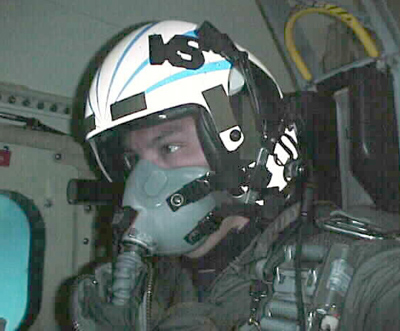
|
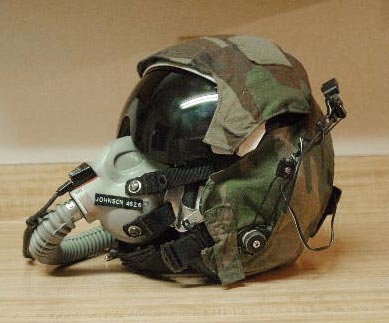
|
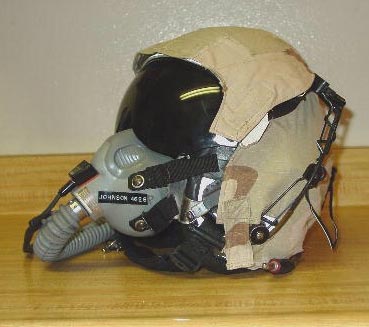
|
HGU-71/P from TACO "Spanky" of US Navy Squadron VS-29 covered with camuflage cloth (Spanky)
|
HGU-72/P ; HGU-73/P
The US NAVY HGU-72/P was the same as the HGU-68/P but with modification in avionic for the utilization on OV-10 Bronco. EEU-7/P visor and boom mounted microphone are installed.
The HGU-73/P helmet is alternative to the HGU-72/P and it is based on PRU-51/P shell with PRU-36/P or EEK-3/P visor. |
|
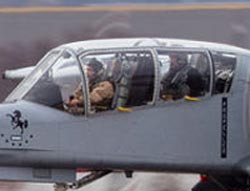
|
USMC Broco pilots with HGU-72 or HGU-73 Flight helmet (USMC)
|
 |
HGU-74/P ; HGU75/P
The US NAVY HGU-74/P was the same as the HGU-68/P but with modification in avionic for the utilization on E-2 Hawkeye. EEU-7/P visor and boom mounted microphone are installed.
The HGU-75/P helmet is alternative to the HGU-74/P and it is based on PRU-51/P shell with PRU-36/P or EEK-3/P visor. |
|
E-2 crewman with HGU-74/P.
|
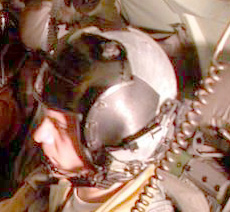
|
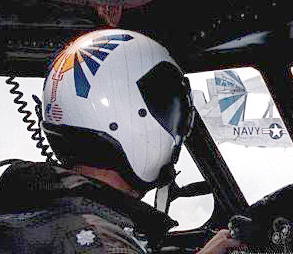
|
E-2 pilot wearing an HGU-74/P. |
HGU-74/P with the marking of VRC-30 Squadron. (Surplusagent)
|
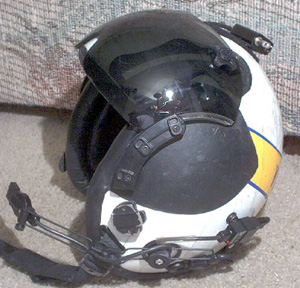
|
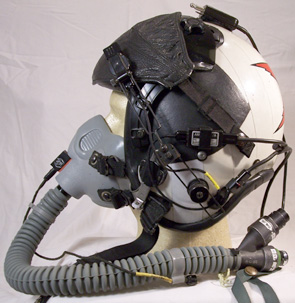
|
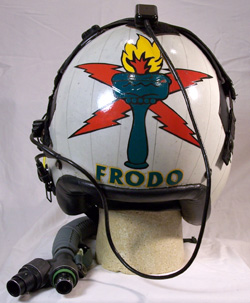
|
HGU-74/P from VAW-115 "Liberty Bells" with oxygen mask MBU-17(V)5/P. this mask is unique in that it has the CRK-90
connector which is only used in the E-2C equipped with the
backpack emergency equipment. (jpayne)
|
 |
HGU-78/P ; HGU-79/P ; HGU-80/P ; HGU-81/P ; HGU-82/P
These typology of US NAVY flight hemet are the same of the HGU-68/P. The helmet's nomenclatures are due to differencies in communications elements (cables, amplifier, microphones etc..) based on specific aircraft utilization.
The HGU-78/P based on PRU-55/P shell with EEU-7/P is used by P-3 Orion crew
The HGU-79/P based on PRU-55/P shell with EEU-7/P is used by C-2A Greyhound crew.
The HGU-80/P helmet is alternative to the HGU-79/P and it is based on PRU-51/P shell with PRU-36/P or EEK-3/P visor.
The HGU-81/P based on PRU-55/P shell with EEU-7/P is used by T-34B/C Mentor crew.
The HGU-82/P helmet is alternative to the HGU-81/P and it is based on PRU-51/P shell with PRU-36/P or EEK-3/P visor. |
US Navy P-3 Orion crewman with HGU-78/P.
(US NAVY) |
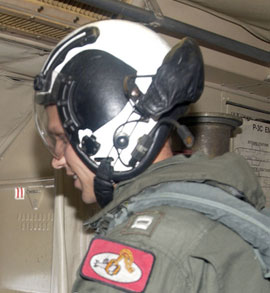
|
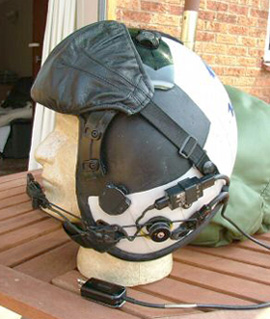
|
US Navy HGU-79/P with boom mounted microphone utilized by C-2A Greyhound squadron VRC-40.
|
| US Navy T-34B/C Mentor Flight Instructor with HGU-81/P flight helmet. (US NAVY) |
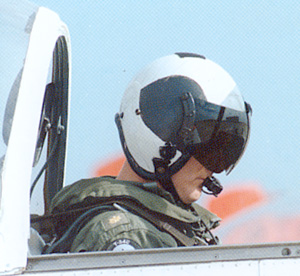
|
 |
Tactical Air Helmet (based on modified HGU-55/P and HGU-83/P concept)
The HGU-83/P was originally designed as the single visor version of the helicopter helmet HGU-84/P which in the very first development was foreseen with two fixed visors under a visor housing with a V-shaped cutout in front of the NVG.
The HGU-84/P was eventually designed with a single not fixed lighweight visor so the fixed visor ideas were scrapped as were the HGU-83/P designation.
A modified HGU-55/P made of lightweight kevlar shell (total weight 2lbs 6oz.) with visor "fast jet" based on HGU-83/P helmet concept (or at least a similar fixed visor mechanism installed on other helmets typology) has been developed by Gentex during the early 90s . |
|
| US Navy Admiral on F-14D Tomcat wearing what seems to be the Tactical Air Helmet with HGU-83/P visor concept.(US Navy) |
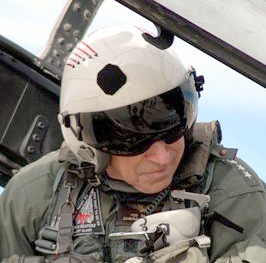
|
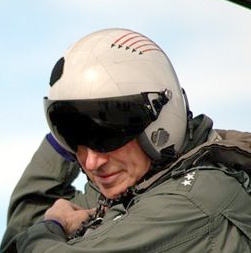
|
In this image the unusual visor mechanism, probably based on the HGU-83/P concept, is clearly visible.
(US Navy) |
Drawing from a Gentex datasheet showing both the HGU-83/P and HGU-84/P in their originally intended configuration with fixed visors under visor housing. (Bluelight)
|
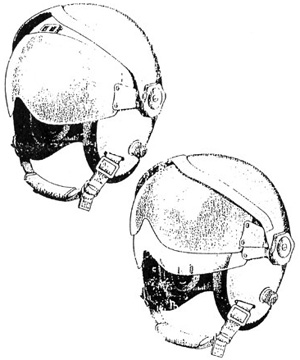
|
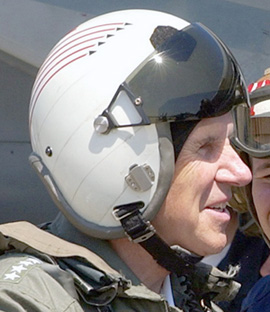
|
Lateral view of what seems to be the Gentex Tactical Air Helmet based on HGU-55/P shell and HGU-83/P visor concept customized for utilization on fighter aircraft. (US NAVY) |
Gentex Tactical Air Helmet based on modified HGU-55/P lightweight kevlar shell and HGU-83/P visor concept. (Surplusagent)
|
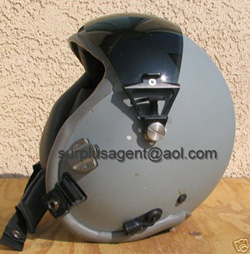
|
Beautiful HGU-83/P Gentex Tactical Air Helmet (Bellsaviation.com)
|
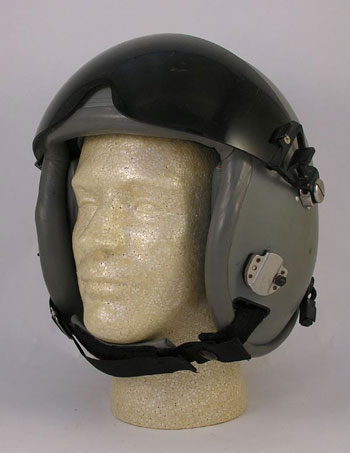
|
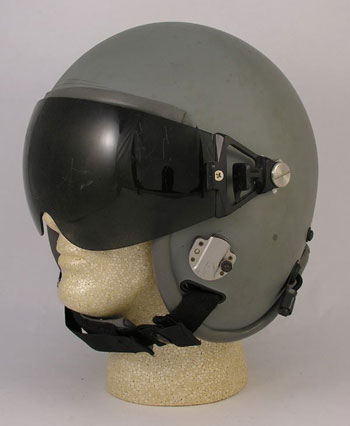
|
 |
HGU-84/P
Developed for the U.S. Navy and U.S. Marine Corps, the HGU-84/P rotary wing helmet with a dual visor helmet assembly integrates the latest advances in technology to provide superior protection, stability, retention and comfort in a lightweight, low-profile design.
The helmet system integrates with the MBU-14/P MBU-23/P Oxygen Mask, MCK-3/P mask, AN/AVS-6 Night Vision Goggles, and EDU-1/P spectacles. The helmet's frontal opening is cut back in the temple regions to provide the maximum peripheral vision to the user.
Made of rigid Graphlon composite shell, the HGU-84/P has a leather edgeroll covering its soft foam core periphery. A nominal one-half inch Styrofoam energy absorbing liner is the primary impact attenuation medium and the custom liner - the ThermoPlastic Liner (TPL) provides an easy, lightweight and comfortable fit.
The helmet's integrated chin/nape strap is a unique, one-piece assembly threaded through the helmet. It adjusts at the chin strap and cross straps threaded through the nape strap pad adjust simultaneously with the chin strap to provide a snug, yet comfortable fit. It is a favorite with Night Vision Goggle wearers.
The helmet incorporates lightweight tapered plastic earcups that include a cushioned earseal with a raised inner ring for maximum sound attenuation and comfort, in addition to a foam earphone holder and a set of spacer pads for optimal fitting comfort.
Atop the helmet, the dual visor helmet assembly features an inner clear visor and outer neutral gray visor that attaches to each other and to the helmet with snap fasteners. All GENTEX visors are made of polycarbonate and meet all performance requirements of MIL-V-43511.
The helmet can be upgraded to include optional laser visors and high contrast visors. Additional upgrades or accessories for the HGU-84/P include the MaxilloFacial Shield, Flex Boom Microphone, and Night Vision Goggle Mount.
The HGU-84/P is used on all the U.S. Navy and U.S. Marine Corps rotary wing aircrafts as well as on the tiltrotor aircraft MV-22 Osprey.
|
|
| US Navy HGU-84/P used on rotatory wing aircraft (US Navy) |
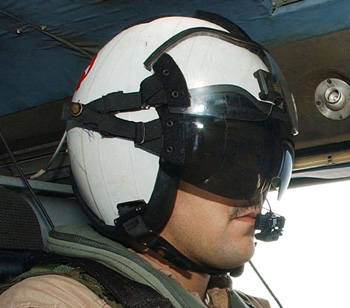
|
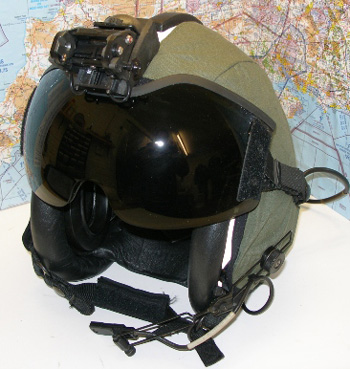
|
USMC HGU-84/P with Night Vision Goggle Mount installed |
HGU-84/P from US NAVY Squadron HC-8 (Now HSC-28) flying on MH-60H (flighthelmetsltd.com)
|
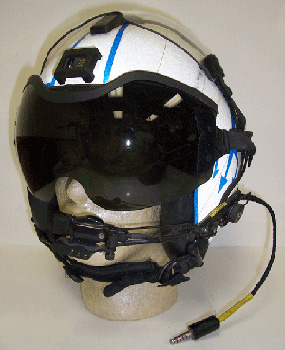
|
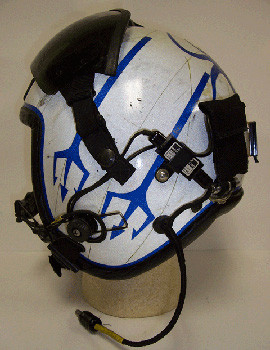
|
Gentex's new HGU-84/P MaxilloFacial Shield was developed for the U.S. Navy. The shield protects the lower face from rotor wash and flying debris and improves voice communications by reducing wind noise. (Gentex)
|
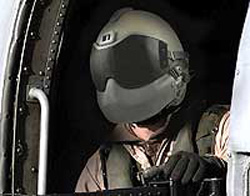
|
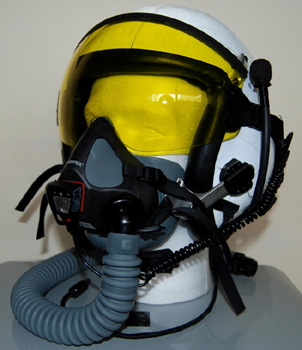
|
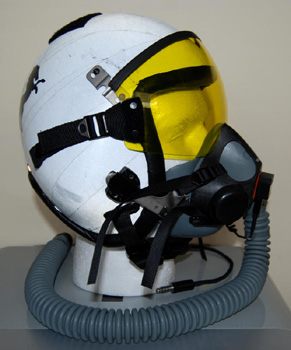
|
HGU-84/P with MBU-23/P oxygen mask used on tiltrotor aircraft MV-22 Osprey. |
| US Marines pilot of a CH-46 Helicopter with an HGU-84/P. Note the decal with the comic character Calvin peeing on MV-22. |
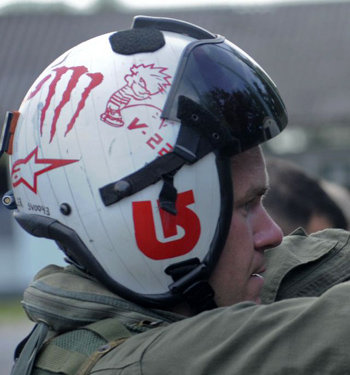
|
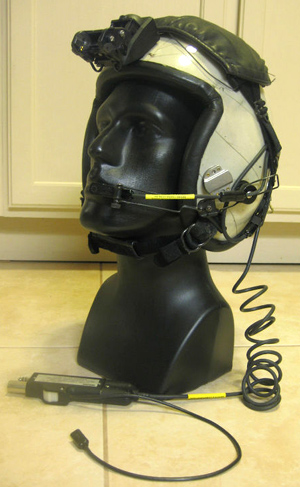
|
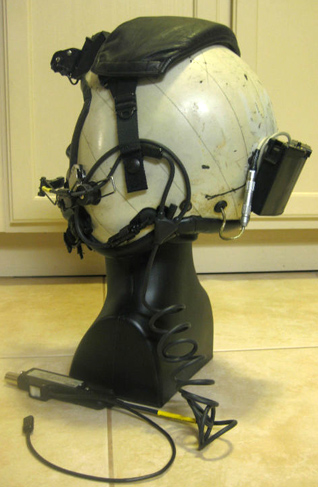
|
HGU-84/P with fixation bracket for night visor google, battery and relevant cables. This helmet was used on tiltrotor aircraft MV-22 Osprey.(Csardude) |
| HGU-84/P, used on tiltrotor aircraft MV-22 Osprey. The helmet is equipped with connection for night visor google, clear visor, external boom mounted microphone and MBU-14/P with the new microphone amplifier. (Csardude) |
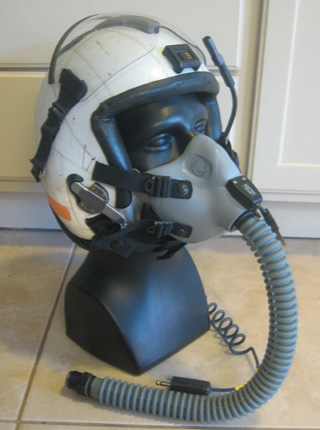
|
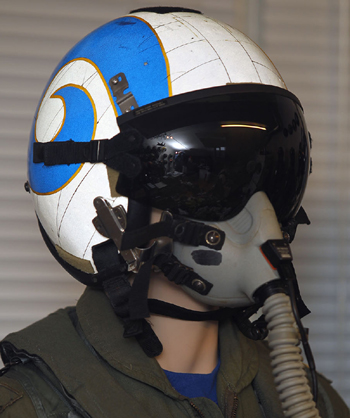
|
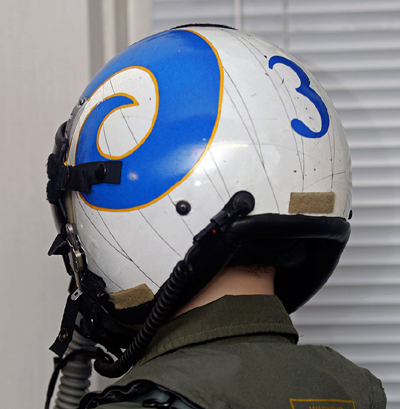
|
HGU-84/P, in the color of the VFA-83 squadron, customized for utilization on jet aicrafts.
This configuration is authorized because the TACAIR Helmets only come in three sizes, M, L and XL. The HGU-84 has an XL Wide shell which is authorized for fix wing crew that do not fit the standard TACAIR XL. Someone that is qualified to fly in fixed wing and helos may also use an HGU-84.
|
| US Marines HGU-84/P used on MV-22 Osprey with desert digit camuflage cover displayed at Smithsonian National Aviation Museum |
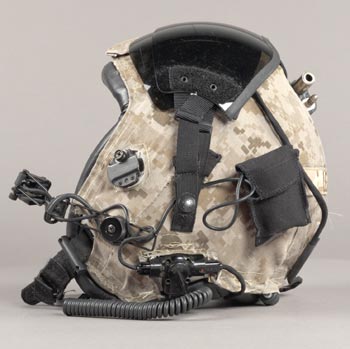
|
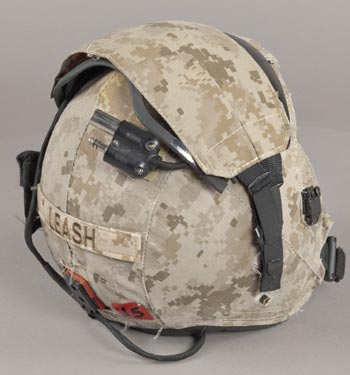
|
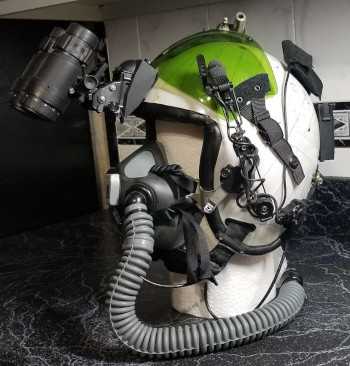
|
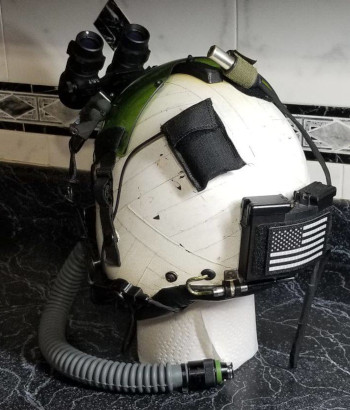
|
Another interesting HGU-84/P, used on tiltrotor aircraft MV-22 Osprey. The helmet is equipped with bracket and rerlevant night visor google, grean visor, external boom mounted microphone and MBU-24/P with the new microphone amplifier. (Shane) |
 |
HGU-85/P
The Gentex HGU-85/P Night Attack Helmet is designed to meet the requirements of the tactical night operating enviroment using "Cats Eyes" Night Vision Goggles. The HGU-85/P is a marriage of the HGU-66/P Night Attack Helmet and the HGU-68/P Tacair Helmet. The HGU-66/P visors and shell are combined with the liner system of the HGU-68/P.
The helmet shell is a rigid composite made of pressure molded, pressure molded, laminated graphite and ballistic nylon (Graphlon). The helmet has the Integrated Chin/Nape Starp Assembly which is a unique one-piece assembly that threads through the helmet and adjusts at the chinstrap and nape area.
A nominal one-half inch styrofoam energy absorbing liner is the primary impact attenuation and a preformed Thermoplastic Liner (TPL) provides an easily fitted, lightweight, confortable custom liner. An NVG mount plate can be placed on the top frontal area of the helmet shell and safety visor it is also provived to replace the neutral grey visor when the Cats Eyes NVGs are utilized. This helmet is utilized with US NAVY MBU's series oxygen mask, which are secureb by two lightweight bayonet receivers. |
|
| HGU-85/P with safety visor installed. The visor is intended for use with "Cats Eyes" NVGs. The lens is anti-fog coated to minimize visor misting. (Flighthelmet.com) |
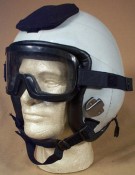
|
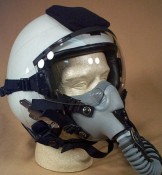
|
HGU-85/P with clear visor assembly. Note The black cloth on top of helmet installed to cover the NVG mount plate and to protect the visor from the scratches (Flighthelmet.com) |
HGU-85/P from US NAVY Squadron VFA-94 with NVG mount plate and MBU-14/P oxygen mask. (flighthelmet.com)
|
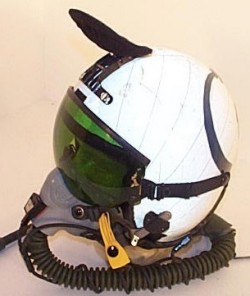
|
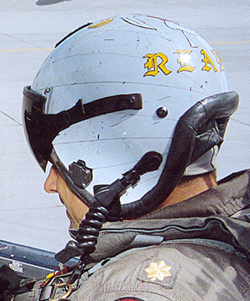
|
NFO of VF-32 "Swordsmen" on F-14B wearing a probabble HGU-85/P modified with mounting brackets for NVG Detachable Helmet Mounting Plate Assembly.(TomCat Publishing Ltd.) |
Unusual HGU-85/P customized with HGU 68/P external visor and lateral leather elements.
|
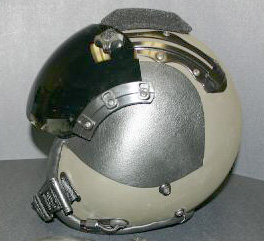
|
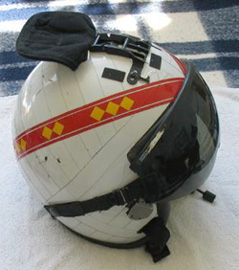
|
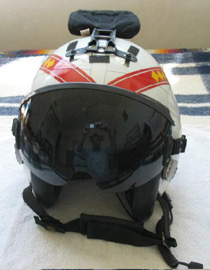
|
HGU-85/P of USMC Squadron VMFA-323 "Death Rattlers" with NVG mount plate. (geeindustry) |
| HGU-85/P modified with mounting brackets for NVG Detachable Helmet Mounting Plate Assembly and MBU-14/P Oxygen mask. (Csardude) |
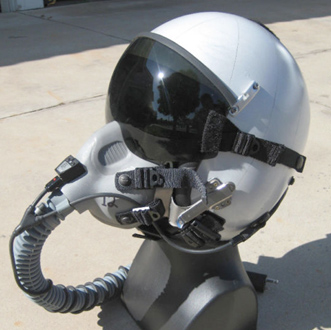
|
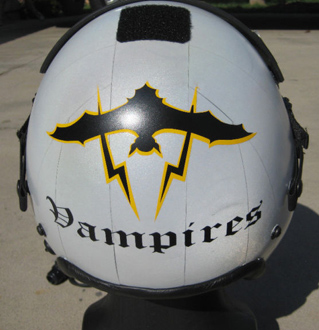
|
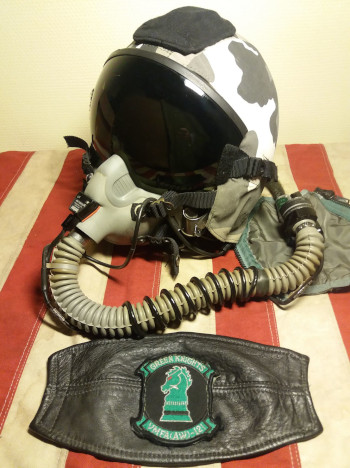
|
Beautifull USMC HGU-85/P and MBU-14/P Oxygen mask from VMFA(AW)-121 Green Knights (Niki Helsen). |
| Beautiful HGU-85/P with MBU-14/P Oxygen mask of the late of the 80s. |
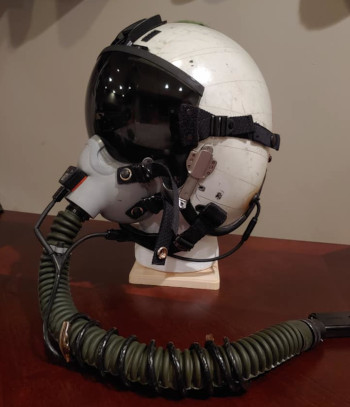
|
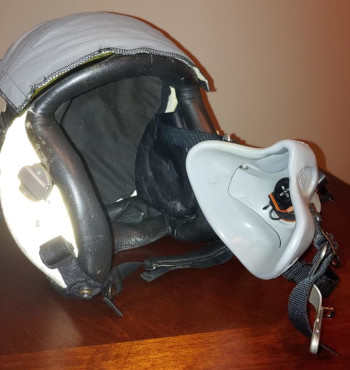
|
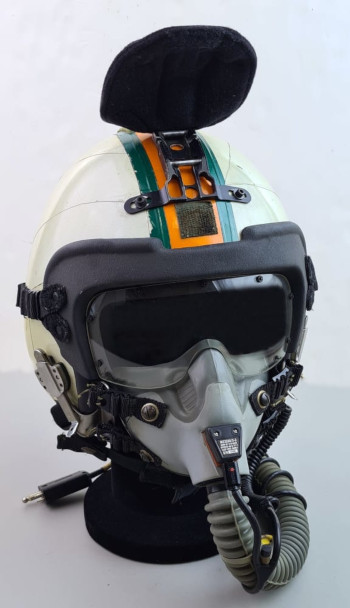
|
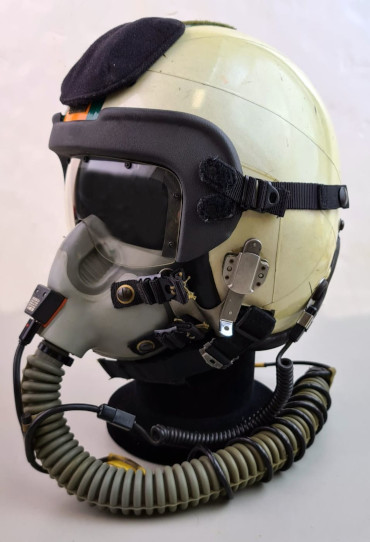
|
Beautifull US Navy HGU-85/P from VA-95 and oxygen mask MBU-14/P . |
| Brand new HGU-85/P with MBU-14/P Oxygen mask with NVG installed (Philippe Tondeur collection) |
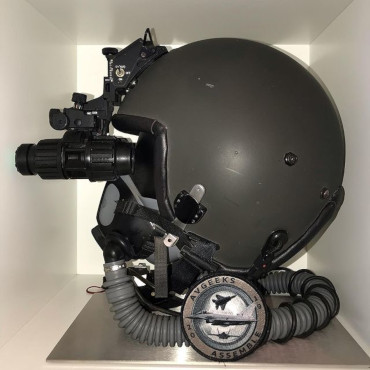
|
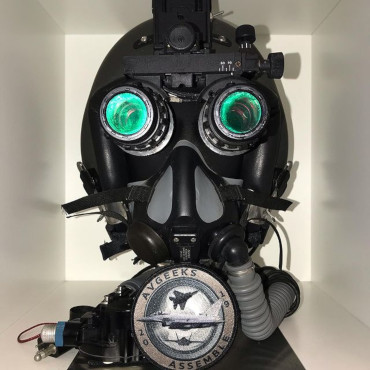
|
 |
Advanced Tactical Life Support System ATLSS
The ATLSS developed by Gentex during the early 90s is a high-performance integrated system designed to give fighters pilots the maximum endurance to high gravitational (G) maneuvers. The system is the US NAVY configuration of the USAF Combat Edge System.
The ATLSS consists of a modified HGU-68/P helmet that incorporates an inflattable bladder to provide automatic mask-tensioning during PBG; a low profile, low breathing resistance MBU-24/P oxygen mask; a chest-mounted breathing regulator; a counterpresure vest; the anti-G pants; and an airframe mounted G rate-sensitive, high-flow anti-G valve. |
|
US NAVY modified HGU-68/P with modified MBU-20/P combat edge oxygen mask (with US NAVY standard communication cable, microphone and two parts inflattable hose) parts of the Advanced Tactical Life Support System
|
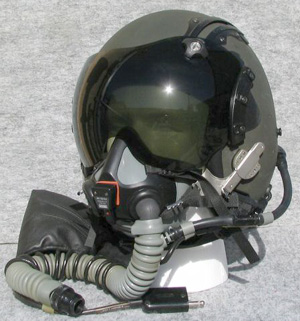
|
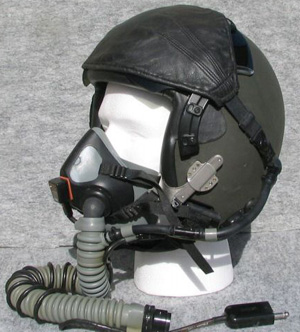
|
The ATLSS designed during the early 90s consists of a modified HGU-68/P (labeled as ATLSS). This early valutative Helmet never goes on mass production being operatively replaced by the ATLSS HGU-87/P and HGU-89/P. |
The US NAVY ATLSS was desigen to be utilized on high performance aircraft as the F-18 (Gentex) .
|
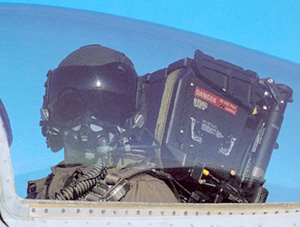
|
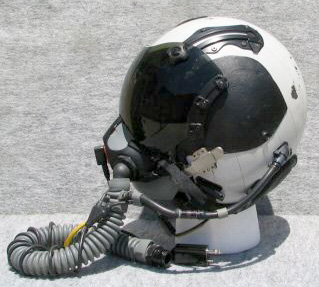
|
US NAVY modified HGU-68/P covered with reflective tape and modified MBU-20/P (with US NAVY standard communication cable, microphone and two parts inflattable hose) combat edge mask. (surplusagent) |
 |
HGU-87/P
The ATLSS HGU-87/P TACAIR Helmet is an HGU-68/P modified by Air Crew Systems Change incorporating the Navy Combat Edge inflatable helmet bladder assembly. This helmet is one of the component of the NAVY ATLSS system which provides pressure breathing for G (PBG) capability to fighter aircrew to reduce the probability of G-induced loss of consciousness (GLOC) during high performance flight.
When integrated with the ATLSS system the HGU-87/P helmet provides automatic mask tensioning during PBG to keep the mask in position under pressure but only at high G so the pilot does not have to wear the mask uncomfortably tight at all times. The HGU-87/P is utilized with US NAVY oxygen mask MBU-24/P. |
|
US NAVY HGU-87/P with Enhanced Pressure-Demand Oxygen Mask Assembly MBU-24/P
|
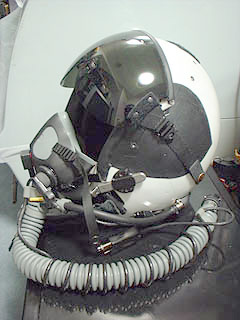
|
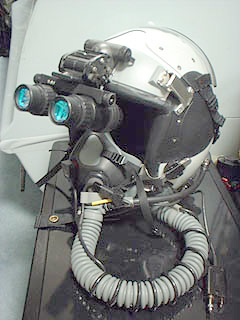
|
HGU-87/P with MBU-24/P oxygen mask and NVG Detachable Helmet Mounting Plate Assembly with installed the relevant AN/AVS-9 Aviator's Night Vision imaging System (ANVIS) "Catseye". |
Navy Combat Edge (NCE) HGU-87/P of US NAVY Squadron VFA-113 "Stingers".
|
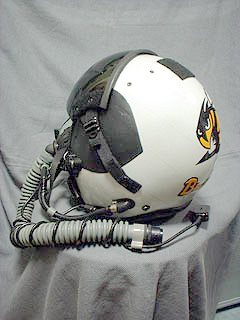
|
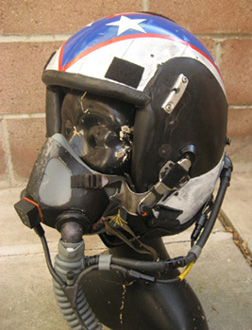
|
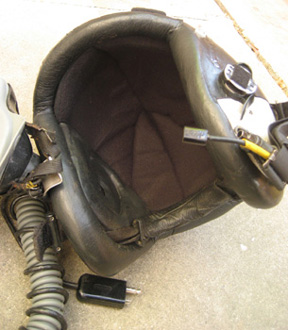
|
Navy Combat Edge HGU-87/P of USN Squadron VFA-22 ""Fighting Redcocks" with MBU-24/P Oxygen mask. |
| Navy Combat Edge HGU-87/P of USN NSAWC and MBU-24/P Oxygen mask with USAF communication cable. This helmet was used by US Navy adversary pilot on F-16A and F-16B |
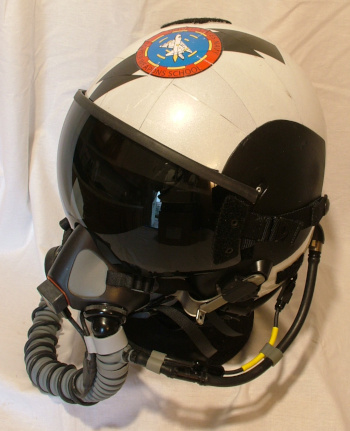
|
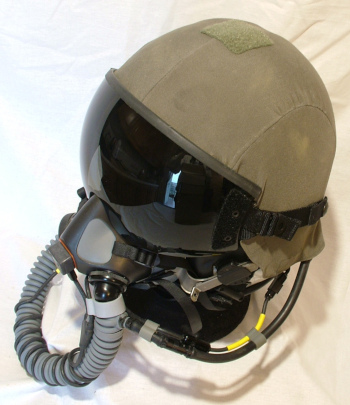
|
HGU-89/P
The ATLSS HGU-89/P TACAIR Helmet is a modified HGU-85/P. This modification incorporates the same bladder assembly as the HGU-87/P22P-16 helmet, and also provides for the use of MXU-810/U Night Vision System. It can be modified to accommodate the AN/AVS-9 Night Vision Image Intensifier Set (NVIIS).
The HGU-89/P is utilized with US NAVY oxygen mask MBU-24/P. |
|
Probable US NAVY Combat Edge HGU-89/P with MBU-24/P oxygen mask.
|
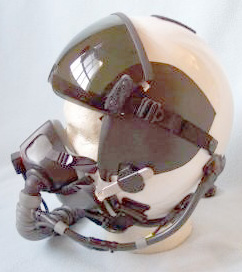
|
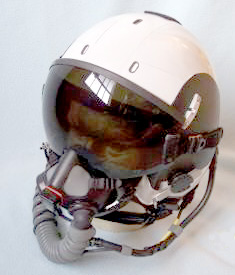
|
Probable HGU-89/P (NCE) helmet. Note the holes for the (not installed) NVG mount plate typical on the HGU-66/P and HGU-58/P helmet models. |
US NAVY Combat Edge HGU-89/P with safety visor and MBU-24/P oxygen mask. (CSARdude)
|
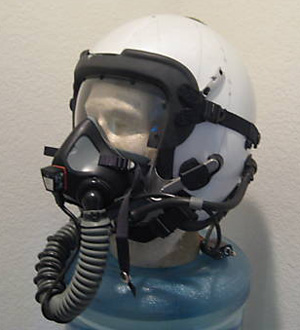
|
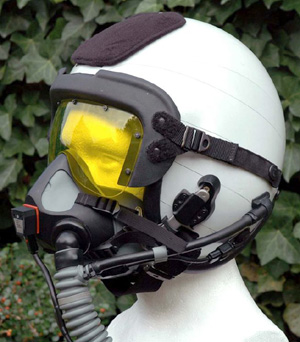
|
Another beautiful example of HGU-89/P (NCE) helmet with HGU-85/P NVG mount plate, safety visor and MBU-24/P oxygen mask. (Joeri Sarens) |
 |
Navy Combat Edge CBR
Further new introduction into the US NAVY, is the Navy Combat Edge Chemical/Biological/Radiation (CBR) exposure protection system.
This probably being the follow up to the AR-5 CBR mask. |
|
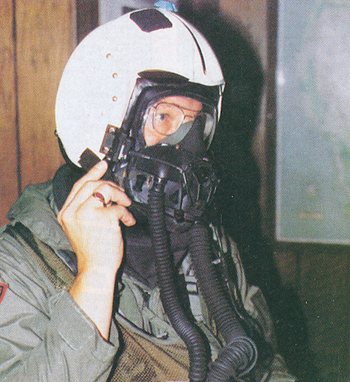
|
US Navy chemical Biological Radiological (CBR) worn with the HGU-33/P helmet (US Navy) |
| US NAVY Chemical/Biological/Radiological (CBR) exposure protection system ((Flighgear On-Line). |
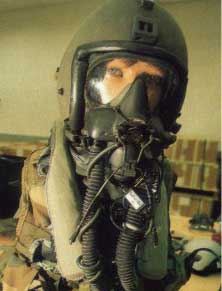
|
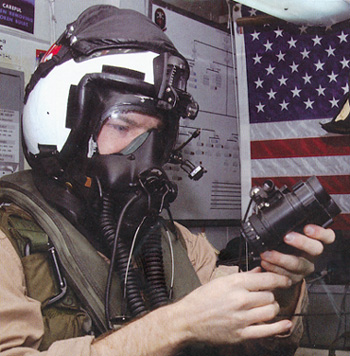
|
Naval Aviation Anti-Submarine Warfare officer receives his chemical Biological Radiological (CBR) mask on board of USS Abraham Lincoln on 2003. (US Navy) |
 |
JHMCS
The Joint Helmet-Mounted Cueing System (JHMCS) is intended to be used with the AIM-9X Sidewinder missile. This highly accurate cueing system provides pilots with "first look, First shot" high off-boresight weapons engagement capabilities. JHMCS enable the pilot to accurately direct (cue) the missile against enemy aircraft while performing high-G aircraft maneuvers.
The pilot needs only to point his head at the target and weapons will be directed to where the pilot is looking. The system can also be employed to accurately cue the pilot to ground target. This helmet is utilized by F/A-18E,F Super Hornet pilots with Oxygen mask MBU-16/P and MBU-23/P.
The JHMCS is also used with the new Night Vision Cueing and Display (NVCD) This system incorporates the same symbology - including airspeed and altitude, heading, and where the aircraft sensors are looking - shown in the JHMCS into a four-tube night vision goggle. The only difference is that it is injected into a tube on the goggles overlaying the night scene. There is also a camera mounted on the goggle that records everything, which serves as a useful post-flight debrief tool. The two outer tubes can be removed creating a two-tube version, known as Mini-QuadEye.
Configuring the JHMCS for the Mini-QuadEye is easy. The goggles simply snap onto the front of the helmet and can be modified for individual preferences. |
|
UN NAVY F/A-18/E pilot of VFA-14 "Tophatters" with the new Joint Helmet-Mounted Cueing System.
(www.steehouwer.com)
|
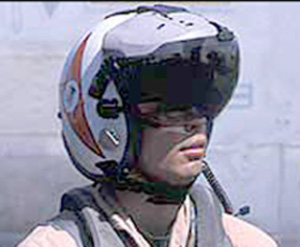
|
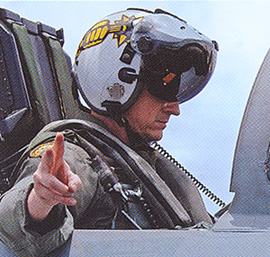
|
VFA-27 "Royal Maces" pilot with the new JHMCS helmet. (US Navy) |
| US Navy F/A-18F pilot of VFA-41 "Black Aces" wearing a JHMCS. (US Navy) |
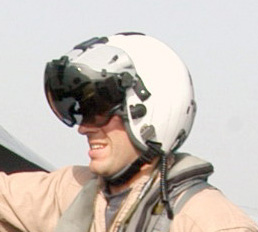
|
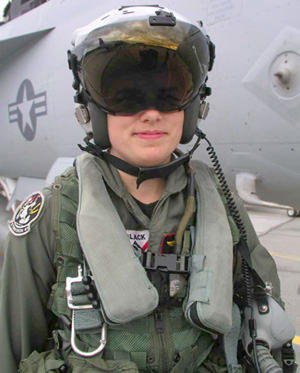
|
VFA-41 "Black Aces" female pilot is wearing the new JHMCS. (US Navy) |
US Navy JHMCS helmet with the new Night Vision Cueing and Display (NVCD) This system provides Joint Helmet Mounted Cueing System (JHMCS) functionality integrated into night vision devices providing improved situational awareness for pilots during night flights. The new night vision system is a follow-on to the JHMCS, a joint effort between the Navy and the Air Force. The Navy and MARINES Corps use the day helmet system in the F/A-18E/F Super Hornet and have begun installing the system into the F/A-18C. Installation of a dual seat capable system into the F/A-18D is scheduled to begin later 2008.
(US NAVY) |
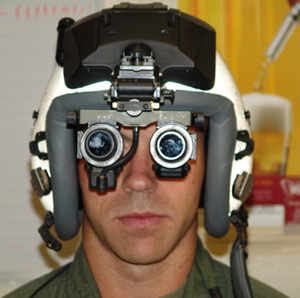
|
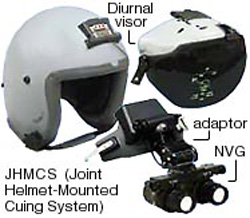
|
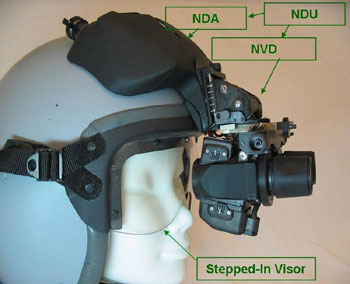
|
The QuadEye NVCD system incorporates the same symbology - including airspeed and altitude, heading, and where the aircraft sensors are looking - shown in the JHMCS into a four-tube night vision goggle. The only difference is that it is injected into a tube on the goggles overlaying the night scene. There is also a camera mounted on the goggle that records everything, which serves as a useful post-flight debrief tool. The two outer tubes can be removed creating a two-tube version, known as Mini-QuadEye.
Configuring the JHMCS for the Mini-QuadEye is easy. The goggles simply snap onto the front of the helmet and can be modified for individual preferences.
|
| US Navy JHMCS of VFA-14 "Tophaters" used on F/A-18E.
| 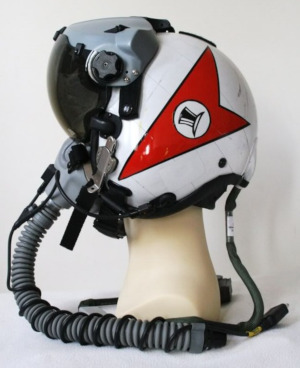
|
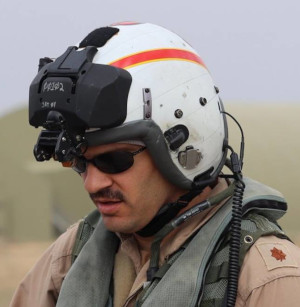
|
US Navy E/A-18G pilot with JHMCS helmet fitted with the new Night Vision Cueing and Display (NVCD). (US Navy)
|
| US Navy JHMCS in the color of VFA-87 "Golden Warriors" (Philippe Tondeur collection)
| 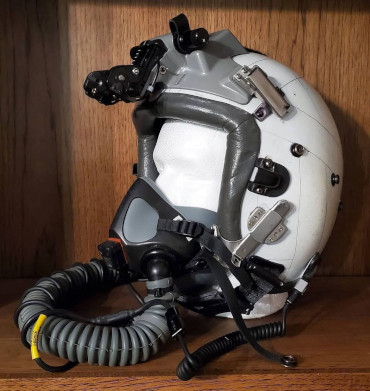
|
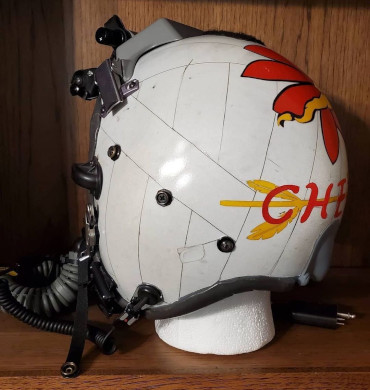
|
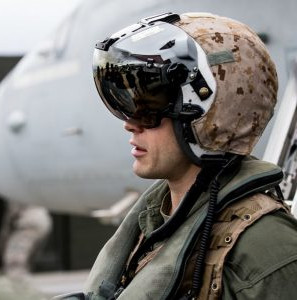
|
USMC F/A-18 pilot with JHMCS helmet covered with camuflage cloth.
|
| The Naval Aircrew Systems Program Office (PMA-202) is leading the design and modification of the F/A-18 and EA-18G pilot helmet-mounted components of the Improved Joint Helmet-Mounted Cuing System (IJHMCS), making the system lighter in weight and with a better center of gravity to reduce potential for pilot back and neck injuries. The Navy is performing a technology refresh that includes a single high-definition day and night color display. (US Navy)
| 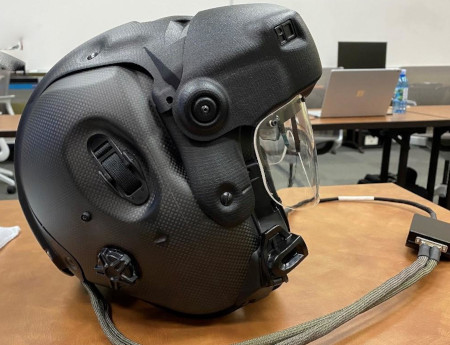
|
 |
HMDS
Vision System International LLC is now under contract to develop the Helmet Mounted Display System (HMDS) for the F-35 Joint Strike Fighter aircraft. Some of the features that will be provided by this next generation helmet system include: Binocular Wide Field-of-View, Integrated day/night capability with sensor fusion, Highly accurate head tracking hardware and software, Digital image source for helmet vision displayed symbology, Custom helmet shell, liner and suspension system for lightest weight, optimal C.G. and maximum pilot comfort.
|
|
| The John H. Glenn squadron of the Marine Corps Aviation Association (MCAA) selected Marine Corps Maj. Richard Rusnok as test pilot of the year for his role in the successful embarkation and deployment of more than 250 people and 140,000 pounds of supplies and equipment with two F-35B test aircraft on USS Wasp (LHD 1). |
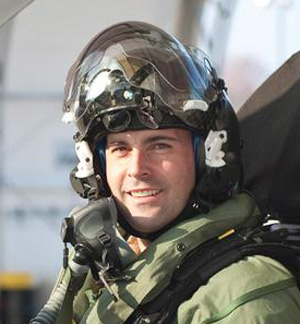
|
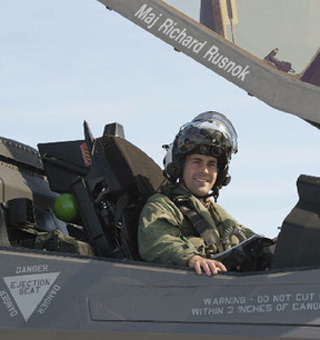
|
Marine Corps Maj. Richard Rusnok with HMDS helmet tested on F-35B. The HMDS also provides HUD information as though pilots are looking through an actual HUD no matter in what direction they turn their heads. |
| Frontal view of the HMDS tested on F-35 Joint Strike Fighter. |
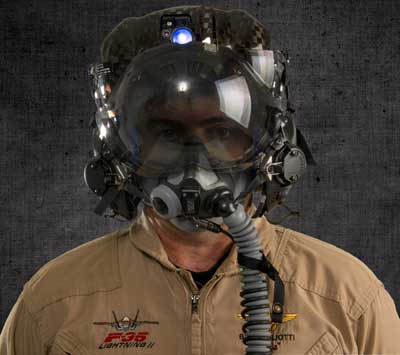
|
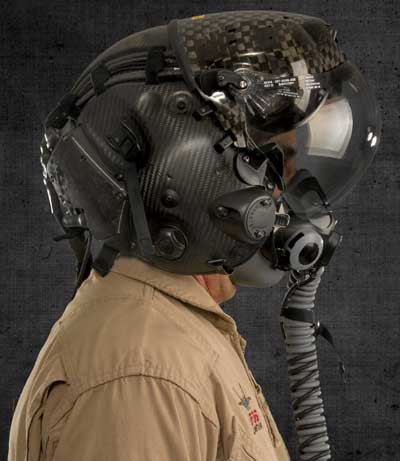
|
Side view of the HMDS tested on F-35 Joint Strike Fighter |
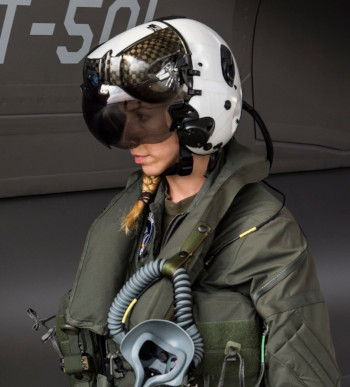
|
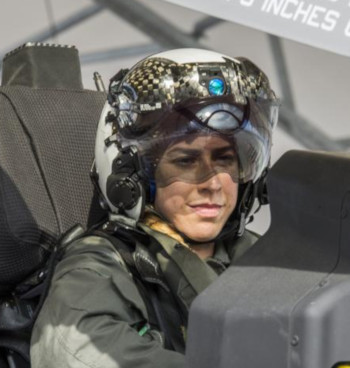
|
USMC first female pilot of F-35B from VMFAT-501 with HMDS helmet
|
|






























































































































































